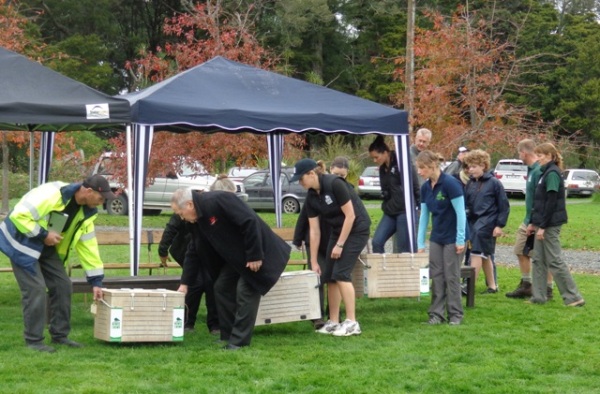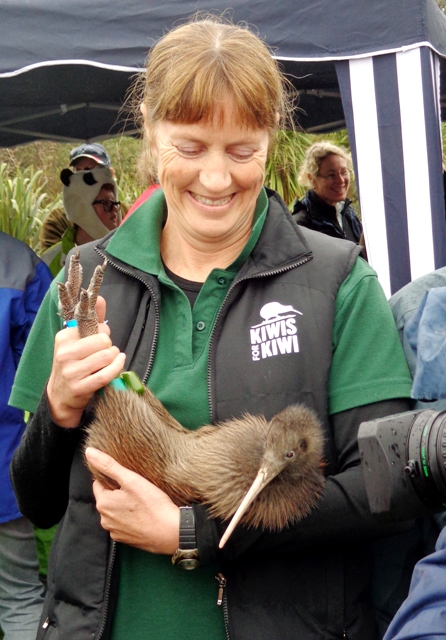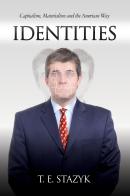A Kiwi Encounter
I have lived in New Zealand for a little over ten years and last Sunday I was privileged to participate in a ceremony that few people experience. Our neighbours at CUE Haven released endangered native kiwi birds onto their property. This is the first time in 50 years there are kiwi on private land in the Kaipara Harbour area and the kiwis released on Sunday are now the closest wild kiwi to Auckland, New Zealand’s largest city.
Most New Zealanders would agree that the kiwi bird is our national symbol. We call ourselves ‘kiwis” and the image of the kiwi bird appears on everything from our money, our soldiers’ uniforms, postage stamps and, in various caricatures, as a symbol of everything from rental cars to quality builders.
Unfortunately, the kiwi is seriously endangered. Before humans came to New Zealand, there was only one indigenous mammal, a small bat, and no snakes or carnivorous reptiles. As a result, many indigenous New Zealand birds, including the kiwi, have no wings. Even birds that fly often spend a lot of time on the ground and nest on the ground.
When humans introduced dogs, cats, rats and weasels, the indigenous bird population was in serious trouble. Today all species of kiwi are endangered. Of the small percentage of wild kiwi eggs that hatch, only 5% of the chicks survive to adulthood. Almost 95% of those killed are killed by dogs.
As a result, most New Zealanders have never seen a kiwi or heard their amazing calls in the wild. There are a number of kiwi refuges on predator free islands or in reserves where predators are controlled, but a kiwi population cannot be sustained without protection from predators.
Our friends and neighbours, Gill and Kevin Adshead have set aside 400 ha (990 acres) of native bush and salt marsh on their 1300 ha (3200 acres) farm, Mataia, http://www.mataia.co.nz/ on the Kaipara Harbour as a native New Zealand forest reserve. They have long dreamt of bringing kiwi back to the Kaipara and that dream became a reality on Sunday 25 May, 2013.
Kiwi are national treasures and highly protected. The Maori, New Zealand’s indigenous people, consider kiwi to be taonga, which means “treasure,” and under the Treaty of Waitangi between the British Crown and the Maori tribes, Maori have kaitiakitanga (guardianship) of their taonga. Also, the Department of Conservation which manages kiwi reserves will only release kiwi in environments that they are satisfied to be suitable and safe.
Since 2006, Gill and Kevin have undertaken an intensive pest and predator control program to eradicate possums, stoats, ferrets, weasels, cats and rats on the Mataia property. They also fenced their entire property and covered it with shade cloth that will keep the kiwi in and defeat most predators including dogs. Only working farm dogs that have undergone kiwi aversion training are now allowed on to the property. Once all safeguards were in place, it was decided to release fourteen kiwi onto the property.
A specially trained team from the Department of Conservation and Auckland Zoo and two family members spent Friday night on Maturangi Island, a kiwi reserve, to trap fourteen Northland Brown kiwis. Kiwi are nocturnal and only come out at night. It was a full moon so unfortunately not many kiwi came out of their burrows and so despite the team walking around the island several times from 8 pm to past 5 am they were only able to catch five kiwis. These were brought to Mataia on Saturday morning. The team will go back in a few days to catch the remaining nine kiwi.
Because the kiwis were being transferred from one Maori tribal area to another, it was necessary for the gifting iwi (tribe) to introduce the kiwis to their new home and for the iwi that would be receiving the kiwis to formally accept them. On Saturday morning Maori representatives from the iwis were at Mataia to do the Pôwhiri (formal welcoming ceremonies) and the event was attended by almost 500 guests.
It was a fascinating morning. Three schools in the area and the local community had helped support the kiwi release project and several students, teachers and parents along with neighbours, friends and local government representatives came for the day. There was also a lot of media coverage as it was over 50 years ago that the last kiwi was seen in the Auckland region.
It was first necessary for there to be a formal welcome of manuhiri (visitors) to the Mataia property by the local iwi, Ngati Whatua o Kaipara, and Gill & Kevin’s families. My wife and I were honoured to be considered part of Gill and Kevin’s family. The manuhiri assembled at the entrance to the Mataia Homestead and were welcomed by the Kuia (female elder) from the local iwi with a karanga (call) and invited to take seats across from where tangata whenua (local people) sat.
The manuhiri assembled at the entrance to the Mataia Homestead and were welcomed by the Kuia (female elder) from the local iwi with a karanga (call) and invited to take seats across from where tangata whenua (local people) sat. The local iwi kaumatua (elder) then welcomed everyone and gave a speech explaining whakapapa (the genealogy) of the local tribe and the local area. The speech was in Maori followed by an English translation.
The local iwi kaumatua (elder) then welcomed everyone and gave a speech explaining whakapapa (the genealogy) of the local tribe and the local area. The speech was in Maori followed by an English translation. The Department of Conservation representative then gave a speech in response on behalf of the kiwi sanctuary. This speech was followed by a speech from the representative of the manuhiri explaining who they were and their background.
The Department of Conservation representative then gave a speech in response on behalf of the kiwi sanctuary. This speech was followed by a speech from the representative of the manuhiri explaining who they were and their background. The purpose of these speeches was to help establish the identity of the various groups and demonstrate that they are present for a peaceful purpose.
The purpose of these speeches was to help establish the identity of the various groups and demonstrate that they are present for a peaceful purpose.
The local Kaumatua then invited the mahuhiri for the hariru (shaking hands) and hongi (touching noses together). This is a symbol of love and peace because at creation, the breath of life was breathed into the nose. The tangata whenua and the manuhiri then got acquainted over morning tea.
The tangata whenua and the manuhiri then got acquainted over morning tea.
 Now that the people had all been introduced and welcomed, it was time to welcome the kiwis to their new home as honoured guests.
Now that the people had all been introduced and welcomed, it was time to welcome the kiwis to their new home as honoured guests.
The local tangata whenua welcomed the kiwi with a speech by the kaumatua and waiata (special welcoming songs) by the local school children.
 Gill’s family has owned Mataia since 1870 and her oldest brother also welcomed the kiwi and the visitors and gave a short history of the Gardner family and the Mataia Restoration Project.
Gill’s family has owned Mataia since 1870 and her oldest brother also welcomed the kiwi and the visitors and gave a short history of the Gardner family and the Mataia Restoration Project. Then the representatives of the gifting iwi and the Department of Conservation gave speeches explaining the background of the kiwi and their lineage and formally presented the kiwi to Mataia.
Then the representatives of the gifting iwi and the Department of Conservation gave speeches explaining the background of the kiwi and their lineage and formally presented the kiwi to Mataia.
 The kiwi were blessed by the local kaumatua and formally named and introduced to the community.
The kiwi were blessed by the local kaumatua and formally named and introduced to the community.
 While guests were having lunch the actual release of the kiwis took place deep in the bush and that was handled by the Department of Conservation experts accompanied by a few students and family members.
While guests were having lunch the actual release of the kiwis took place deep in the bush and that was handled by the Department of Conservation experts accompanied by a few students and family members.
Previously, Gill and Kevin had put temporary wooden burrows out for the kiwis. The birds were transferred to those boxes and at night the boxes would be opened for the kiwi to explore their new home.
Each kiwi is fitted with a transmitter so that their movements and health can be monitored.
We were very happy and honoured to be part of the very special celebrations and ceremonies and welcome the return of kiwi to the Kaipara Harbour. More kiwi will be released at Mataia in the following week.
CUE Haven is less than a kilometre from Mataia and we are hoping that in the not too distant future, CUE Haven too will be hosts to kiwis.
The event was covered by the New Zealand media and you can see the news clips here and here.











It’s a bird? All my life, I’d been laboring under the misapprehension that a kiwi was a fruit, and that all Oz/NZ kiwi references pertained to that fruit.
Yes, the kiwi is a fruit, but it was named after the bird! The actual name of kiwifruit is Chinese Gooseberry. They were very popular with US service men stationed in NZ during WWII and an export trade was started and the name kiwifruit was developed for branding purposes.
Interesting. You know, last week a driver here in Austria hit and killed a kangaroo that was trying to cross the road: http://bit.ly/11vaR1Y And that’s after I’d been working hard for years to convince Americans that there were no kangaroos in Austria. Now I feel like a fool.
I love this, and I love there is this effort to honor this bird. I too was a little confused about the origin or Kiwi. First I thought it was a fruit, then I thought it was a tribe, but it is an endangered bird. Interesting looking bird too.
Sad, so many of them die. But this movement to save and honor them may yield more and more protection? Nice share..
Thanks. Yes, the fruit is named after the bird, The theory is that the kiwi fruit resembles a kiwi bird–small, brown and fuzzy!
AH!!!! YES!!! I see it!!! Lol. Yes!!!
*Brilliant.*
Those lucky Kiwi’s are at the moment “eyeing” up some tasty morsels over the fence at CUE Haven, I know there are some “tasty” worms there..YUM..
The welcome mat is out for them!
Fantastic commitment on the part of your neighbours, preparing for all those years. I can see you with Kiwis at Cue Haven for sure, Tom. Best wishes to you and your neighbours for your great work in preserving and restoring flora and fauna. Thank you.
Wow. This is so cool. I’m very impressed and full of admiration for people who would take the time and effort to save this dear creature. Bless them!
You have been involved in many projects since you have left Cleveland U.S.A , I look forward to your articles and enjoyed you book Identities ,
time for a new book ,
Fantastic! This is so very interesting. I loved learning a little bit more about the history of indigenous animals and birds in New Zealand. I had no idea Kiwi were so endangered. What a thrill this must have been for you! I’m so glad you shared this heartwarming occasion. 🙂
Long live the Kiwis: both the birds and the people.
Beautiful.
The expression on the faces of those, who held the birds is so heartwarming, it leaves me speechless and, frankly, a little teary-eyed. Such initiatives need to be taken throughout the world to reestablish those that we’ve compromised.
Fascinating feature you have written here, Tom. I love the way you incorporated the language along with its English translation. The photo of the little boy’s face as he petted the kiwi captured the essence of the entire day. I am curious about the dogs that have passed kiwi aversion training. What is their function?
And hip hip hooray to your neighbors and their large tract of land being put to conservation use.
Thanks Cheri. The kiwis are in a preserve that is part of a working farm and the dogs are used to help muster the cows and sheep on the farm. They are very well trained and normally would have no interaction with the kiwis but the aversion training is to make sure they don’t get any ideas in case they should come upon one.